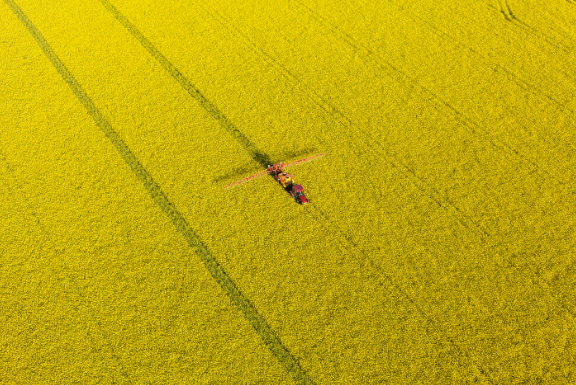Share resources and initiatives related to OSR here

Oilseed Rape is the most widely grown break crop in the UK. The seed is crushed to produce vegetable oil and the remaining rapeseed meal is a high protein animal feed.
Recommended Content
Content below is from across the PEP community and is not necessarily endorsed by Stewards or by PEP
Connected Content
Pollen beetles (Meligethes aeneus) are prevalent during Spring and Summer months and are a significant pest of European oilseed rape.
The major commodity crops in the UK are wheat, barley, oilseed rape, field beans, sugar beet and potatoes, but around half of agricultural land grows grass.
Rapid crop disease detection. SwiftDetect can reveal the level of disease in your crop even in the latent period, with results in 1 business day.
The AHDB Recommended Lists for cereals and oilseeds (RL) publications and resources provide information on yield and quality performance, agronomic features and market options to assist with variety selection. The RL is updated annually with the latest update for 2024/25 being published on 27th November 2023. The latest lists can be accessed online here.
The Cabbage Stem Flea Beetle (CSFB) Psylliodes chrysocephala is a key pest on OSR in the UK and across the EU. They are specialist herbivores of plants in the crucifer's family.
The Claydon Opti-Till® System, is a holistic approach to crop establishment which delivers consistent, high yielding crops at low cost, providing maximum profitability. At the centre of Opti-Till® Seed Drilling System is the Claydon direct strip Hybrid drill, with its unique leading tine technology.
DSV has been established in the UK for over 40 years with an exemplary track record of providing the best seed for many popular agricultural crops including oilseed rape, grasses, winter wheat, barley, maize, cover crops, lupins and linseed.
Light leaf spot (LLS) is a disease of oilseed rape and some vegetable brassicas, caused by the fungus, Pyrenopeziza brassicae. This major foliar pathogen is notoriously difficult to identify with an airborne polycyclic lifecycle – capable of several infection cycles a season, making it hard to control as reinfection is constantly occurring. Severity can be suppressed through monitoring, cultural controls, and targeted fungicide applications.
Oilseed rape diseases can be caused by a variety of factors, including fungal, bacterial or viral infections, pests and insects, and environmental stress.
Establishment in Oilseed Rape key - this extension to the Oilseed YEN aims to encourage growers to share what works in successfully establishing OSR crops, with a 'Beauty Contest' to make it fun.
The encyclopedia of oilseed rape diseases is a guide that was created by ADAS and BASF to help growers identify and understand diseases of OSR. As well as highlight emerging threats such as Verticillium wilt and raise awareness of other economically damaging diseases.
AHDB Project PR623 - Integrated pest management of cabbage stem flea beetle in oilseed
The AHDB Recommended Lists for cereals and oilseeds (RL) publications and resources provide infor
Leaf disease may have been the least of oilseed rape growers’ problems recently but remain a pote
Phoma stem canker is a damaging disease of oilseed rape (Brassica napus) that causes annual yield
Five organic farmers in North East Scotland have launched a pilot project with a comm
At present, we are leaders in the spring field bean market, including varieties such as Lynx, Genius, Futura and newer varieties including Loki and Ketu. We also have competitive oilseed rape varieties, for example Clubroot resistant varieties Crusoe and Crome, HEAR OSR varieties including Resort. Spring Peas including market leader Carrington and butterfly, marrowfats like Takayama and yellow Concerto. Finally we have '00' OSR Maverick, Murray and Vegas, all of which help the UK farmer to maximise their yield.
Oilseeds plants are plants that containing seeds or fruits with a high level of oils and other food fat, used as an energy reserve (Samouco, 1998).
The Oilseed YEN network is striving to help the whole industry to successfully grow Oilseed rape (OSR) and Linseed from start to finish – providing a better outlook for both crops into the future.
A TOOLKIT FOR BREEDING RESISTANCE TO ADULT AND LARVAL HERBIVORY BY THE CABBAGE STEM FLEA BEETLE. BBSRC Industrial Partnership project led by Rachel Wells at JIC looking to breed oilseed rape with resistance to CSFB.
The Defra Pest and Disease survey has been running for approximately 50 years and monitors endemic pests and diseases in winter wheat and winter oilseed rape, along with accompanying information about agronomic practice and pesticide inputs to the crop.
Phoma leaf spot and stem canker is one of the most damaging diseases in oilseed rape, caused by two closely related fungal pathogens: Leptosphaeria maculans (Plenodomus lingam) and L. biglobosa (P. biglobosus).
Verticillium stem stripe is a challenge to identify, especially when other diseases are present. However, because of a lack of chemical control, it is important to locate high-risk fields, so rotational strategies can be adapted.
This guide outlines oilseed rape’s key growth stages and can provide a foundation for management.
Several diseases affect oilseed rape. However, it is possible to suppress the risk of economic damage by combining non-chemical and chemical approaches.
From Crop Action Feb 2022: Sulphur is an essential plant nutrient and
Project report from FERA (James Rainford, Glyn Jones, Roy Macarthur & David Garthwaite) for D
AHDB fungicide performance work provides high-quality, independent information on the efficacy of




